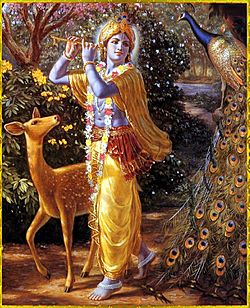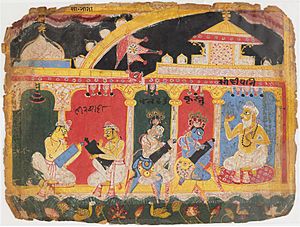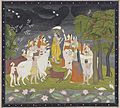Krishna facts for kids
Quick facts for kids Krishna |
|
|---|---|
 |
|
| Affiliation | Svayam Bhagavan, Paramatman, Brahman, Narayana Vishnu, Dashavatara, Radha Krishna |
| Battles | Kurukshetra War |
| Festivals | Krishna Janmashtami, Holi |
| Personal information | |
| Born | Mathura, Surasena (present-day Uttar Pradesh, India) |
| Parents | Devaki (mother) Vasudeva (father) Rohini Devi (step-mother) Yashoda (foster mother) Nanda Baba (foster father) |
| Siblings | Balarama (brother) Subhadra (sister) |
Krishna is a major deity in Hinduism. He is worshipped as the eighth avatar of the god Vishnu and also as the supreme God in his own right. He is the god of compassion, tenderness, and love in Hinduism, and is one of the most popular and widely worshipped among Indian divinities.
Krishna's birthday is celebrated every year by Hindus on Krishna Janmashtami according to the Hindu calendar, which falls in late August or early September of the Gregorian calendar. Krishna is usually depicted with a flute in his hand.
The stories of Krishna's life are generally titled as Krishna Leela. He is a central character and is mentioned in many Hindu philosophical, theological, and mythological texts. They portray him in various perspectives: a god-child, a prankster, a divine hero, and as the universal supreme being. The arts depicting him reflect these legends, and show him in different stages of his life, such as an infant eating butter, a young boy playing a flute, a young boy with Radha, or a friendly charioteer giving counsel to Arjuna.
The name "Krishna" originates from the Sanskrit word Kṛṣṇa, which is primarily an adjective meaning "black", "dark", or "dark blue". The waning moon is called Krishna Paksha, relating to the adjective meaning "darkening". The name is also interpreted sometimes as "all-attractive". Based on his name, Krishna is often depicted in idols as black- or blue-skinned.
Krishna is often depicted wearing a peacock-feather wreath or crown, and playing the bansuri (Indian flute). In this form, he is usually shown standing with one leg bent in front of the other in the Tribhanga posture. He is sometimes accompanied by cows or a calf, which symbolise the divine herdsman Govinda.
Most scholars of Hinduism and Indian history accept that Krishna was a real male person, whether human or divine, who lived on Indian soil by at least 1000 BCE and interacted with many other historical persons.
Contents
Life and legends
This summary is a mythological account, based on literary details from the Mahābhārata, the Harivamsa, the Bhagavata Purana, and the Vishnu Purana. The scenes from the narrative are set in ancient India, mostly in the present states of Uttar Pradesh, Bihar, Rajasthan, Haryana, Delhi, and Gujarat. The legends about Krishna's life are called Krishna charitas (IAST: Kṛṣṇacaritas).
Birth
Krishna is born to Devaki and her husband, Vasudeva, of the Yadava clan in Mathura. Devaki's brother is a tyrant named Kamsa. At Devaki's wedding, according to Puranic legends, Kamsa is told by fortune tellers that a child of Devaki would kill him. Sometimes, it is depicted as an akashvani announcing Kamsa's death. Kamsa arranges to kill all of Devaki's children. When Krishna is born, Vasudeva secretly carries the infant Krishna away across the Yamuna, and exchanges him with Yashoda's daughter. When Kamsa tries to kill the newborn, the exchanged baby appears as the Hindu goddess Yogamaya, warning him that his death has arrived in his kingdom, and then disappears, according to the legends in the Puranas. Krishna grows up with Nanda and his wife, Yashoda, near modern-day Mathura. Two of Krishna's siblings also survive, namely Balarama and Subhadra, according to these legends. The day of the birth of Krishna is celebrated as Krishna Janmashtami.
Childhood and youth
The legends of Krishna's childhood and youth describe him as a cow-herder, a mischievous boy whose pranks earn him the nickname Makhan Chor (butter thief). The texts state, for example, that Krishna lifts the Govardhana hill to protect the inhabitants of Vrindavana from devastating rains and floods.

Krishna's childhood illustrates the Hindu concept of Lila, playing for fun and enjoyment and not for sport or gain. This Lila is a constant theme in the legends of Krishna's childhood and youth. Even when he is battling with a serpent to protect others, he is described in Hindu texts as if he were playing a game. This quality of playfulness in Krishna is celebrated during festivals as Rasa-Lila and Janmashtami, where Hindus in some regions such as Maharashtra playfully mimic his legends, such as by making human gymnastic pyramids to break open handis (clay pots) hung high in the air to "steal" butter or buttermilk, spilling it all over the group.
Adulthood
Krishna legends then describe his return to Mathura. He overthrows and kills the tyrant king, his uncle Kamsa/Kansa after quelling several assassination attempts by Kamsa. He reinstates Kamsa's father, Ugrasena as the king of the Yadavas and becomes a leading prince at the court. In one version of the Krishna story, as narrated by Shanta Rao, Krishna after Kamsa's death leads the Yadavas to the newly built city of Dwaraka. Thereafter Pandavas rise. Krishna befriends Arjuna and the other Pandava princes of the Kuru kingdom. Krishna plays a key role in the Mahabharata.
The Bhagavata Purana describes eight wives of Krishna that appear in sequence as Rukmini, Satyabhama, Jambavati, Kalindi, Mitravinda, Nagnajiti (also called Satya), Bhadra and Lakshmana (also called Madra). According to Dennis Hudson, this is a metaphor where each of the eight wives signifies a different aspect of him.
All of his wives are considered in the Hindu tradition to be the avatars of the goddess Lakshmi, the consort of Vishnu.
Kurukshetra War and Bhagavad Gita
According to the epic poem Mahabharata, Krishna becomes Arjuna's charioteer for the Kurukshetra War, but on the condition that he personally will not raise any weapon. Upon arrival at the battlefield and seeing that the enemies are his family, his grandfather, and his cousins and loved ones, Arjuna is moved and says his heart will not allow him to fight and kill others. He would rather renounce the kingdom and put down his Gandiva (Arjuna's bow). Krishna then advises him about the nature of life, ethics, and morality when one is faced with a war between good and evil, the impermanence of matter, the permanence of the soul and the good, duties and responsibilities, the nature of true peace and bliss and the different types of yoga to reach this state of bliss and inner liberation. This conversation between Krishna and Arjuna is presented as a discourse called the Bhagavad Gita.
Death and ascension
Mistaking the sleeping Krishna for a deer, a hunter named Jara shoots an arrow towards Krishna's foot that fatally injures him. Krishna forgives Jara and dies. The pilgrimage (tirtha) site of Bhalka in Gujarat marks the location where Krishna is believed to have died.
Images for kids
-
Heliodorus Pillar in the Indian state of Madhya Pradesh, erected about 120 BCE. The inscription states that Heliodorus is a Bhagvatena, and a couplet in the inscription closely paraphrases a Sanskrit verse from the Mahabharata.
-
Balarama and Krishna with their attributes at Chilas. The Kharoshthi inscription nearby reads Rama [kri]ṣa. 1st century CE.
-
Krishna lifting Govardhana at Bharat Kala Bhavan, recovered from a Muslim graveyard in Varanasi. It is dated to the Gupta Empire era (4th/6th-century CE).
-
In the foreground, an iconographic symbol of Krishna with Arjuna during the Kurukshetra war – the context for the Bhagavad Gita. The background depicts Krishna's Vishvarupa (cosmic form) described in the Bhagavad Gita.
-
Krishna (left) with Radha at Bhaktivedanta Manor, Watford, England
-
Krishna lifts "Govardhan" mountain, a 7th-century artwork from a Da Nang, Vietnam, archaeological site
-
Depiction of Krishna playing the flute in a temple constructed in 752 CE on the order of Emperor Shomu, Todai-ji Temple, Great Buddha Hall in Nara, Japan
See also
 In Spanish: Krishna para niños
In Spanish: Krishna para niños















